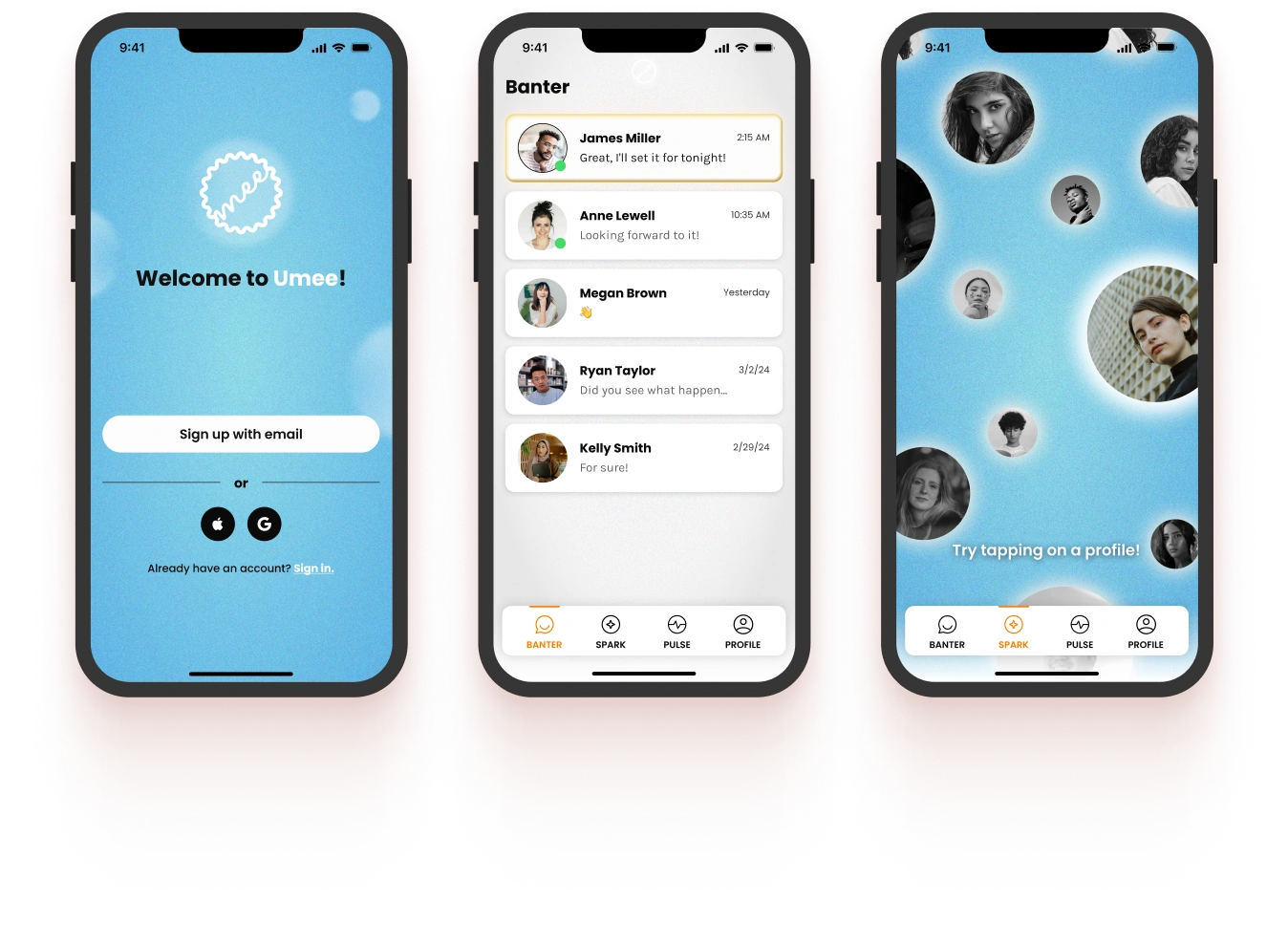
Rebrand project defining brand guidelines and lightweight design system, then building and integrating across all mobile app screens.
Jump to Final DesignRole
UX Designer
Duration
2 Quarters
Deliverables
Brand Guidelines, Design System, High-Fidelity Brand-integrated Screens
Stakeholders
Design Team, Brand Design Lead, CEO
Tools
Figma, Google Suite, Trello
I collaborated with the Brand Design Lead, CEO, and a small design team on Umee's rebrand project to align its visual identity with its mission and core values. The project involved establishing brand guidelines and a design system, which I then implemented across designs for all mobile app screens and delivered to our development team.

Umee lacked brand guidelines, leading to fragmented, inconsistent designs across primary app features.
Our brand identity did not resonate with the needs of our app's target user demographic.
Ensure the design choices reflect Umee's core mission and values, fostering a sense of community and connection among users.
Produce high-fidelity wireframes and UI designs for all app screens, ready for the first live launch and development handoff.
Umee's Vision
Umee is an innovative community-building platform that supports members of exclusive communities (gyms, clubs, and other community organizations) by fostering connection and promoting social wellness.
Umee.socialOur target user group were adults over 40 who are members of exclusive social clubs, such as gyms and community organizations. This demographic was at an increased risk of negative health impact from the loneliness epidemic.
A 2016 meta-analysis found that poor social relationships in this demographic are linked to a 29% higher risk of coronary heart disease and a 32% higher risk of stroke.

Umee planned to soft launch to three gyms the next quarter, so we focused our research on gym members to gain an understanding of exclusive communities. We could later apply our insights to other communities more broadly.
Our goal for research was to identify the user goals for our product.
I collaborated with my team to narrow down qualitative and quantitative questions, and we specifically chose to interview members of gym communities. These are the two participants I interviewed:


Through our user interviews, we found that this older demographic needed to feel the same sense of belonging on the app that they experienced within their fitness communities.
Although they were comfortable with phones and technology, they were initially hesitant to adopt and use a new app within their community.
I led research into three competitors where Umee drew most of its visual inspiration: Nextdoor, Hinge, and Meetup.
Using our research, we needed to define Umee's core brand values to guide Umee's visuals and brand messaging. We worked closely with our CEO to ensure we built from their vision for Umee. My Brand Lead began the visualization process by leading mood board exercises.
Visualization exercises like mood boards based on our user research helped us refine Umee's vision of fostering community into emblematic words and imagery.
We most strived to capture a sense of "belonging" in our imagery.
After weeks of research, visualization exercises, and collaborative discussion, we refined Umee's mission and vision into 3 core brand values.

Umee is a warm, cozy place. The experience should be bright and comfortable.

Umee is rooted in empathetic relationships. Genuine emotional connection is the foundation of positive relationships

Umee is for every member of community, fostering connection between users no matter who their differences.
By the end of the quarter, we solidified Umee’s brand foundation. With the app’s soft launch delayed due to development setbacks, we used Q1 2024 to establish brand guidelines and a lightweight design system.
The brand and design guidelines created the basis for Umee's visual identity that was grounded in its mission and core values.
The Match and Chat (Spark and Banter) features I brought to high-fidelity are the core of the Umee app. These features are a design reference for all sequential features and components.
As new features continue to be built, more design components will need defined:
The true measure of success for this project will come after Umee’s soft launch with three trial gyms. That said, with support from my leads and CEO, the work I’ve done has set Umee on the right path to achieve both our mission and business goals.
Umee is a health & wellness company created to address negative of the loneliness epidemic. Umee's mission is to help members of exclusive communities like gyms, country clubs, and other social groups bond and create new connections.
"The combined insights from studies by Marta Zaraska, Robert Waldinger, and Vivek Murthy redefine our understanding of health and longevity. They show that it’s about more than just what we eat or how often we exercise; it’s about our connections, community, and feeling safe within our communal networks.
Umee offers a practical solution to prioritize our "social fitness" — just as we do our physical fitness. By bridging research and technology, we're presenting a pathway to live longer, healthier, and happier lives. The evidence is clear, and the tools are at hand — it's time to harness the power of connection."
– Umee Mission Statement